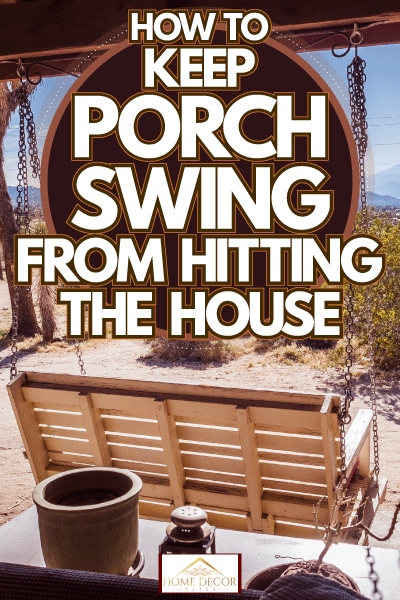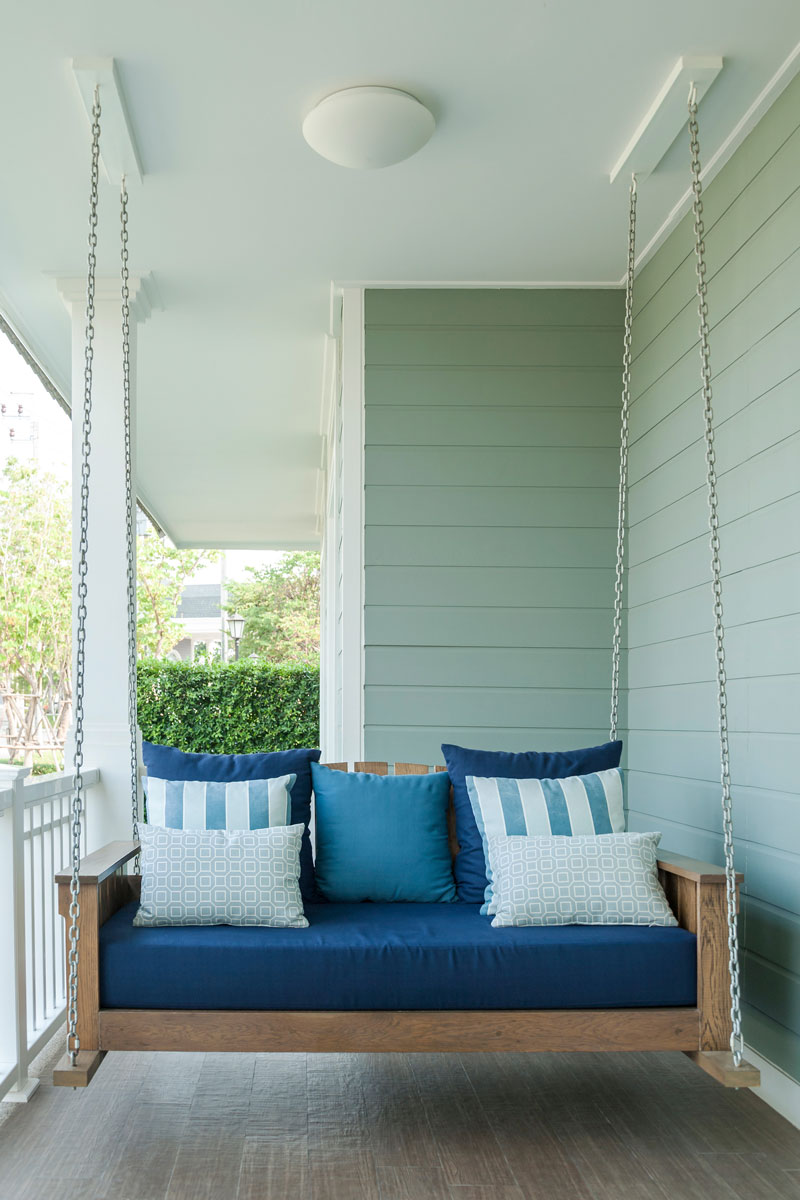So, you find yourself with a porch swing that keeps hitting the house. This is either while you are swinging in the swing or perhaps due to periodic gusts of wind. Whatever the cause, you would like to stop the swing from hitting the house. In this article, we gather and present several tried-and-true techniques to keep the porch swing from hitting the house.
To stop your porch swing from hitting your house, consider the following options. Which option you choose depends on how often you use the swing, your available materials, and the reason your swing hits the house.
- Move the swing farther from the home
- Pad your home
- Secure the swing with strapping
- Set the swing on a solid object
- Wedge the swing still
- Remove swing during storm season
Keep reading the rest of this post for details on how to accomplish each of the above techniques. By reading this guide, you will learn all you need to know to stop that annoying barrage from your porch swing. To conclude, we answer several questions related to the topic of this post.

How To Keep Porch Swing From Hitting The House
As you can tell, the techniques for stopping a porch swing from hitting the house can be split into the category of moving the swing and securing the swing. Generally, if the swing strikes the home while in use by a person, the best option is to physically move the swing farther from the home or pad your home.
On the other hand, if you have a porch swing that routinely bangs into your home during storms or even light breezes, going the route of securing the swing is much easier. In fact, if you live in an area that routinely experiences high winds, securing your swing is a good call to improve swing longevity and integrity.
Move The Swing Farther From The Home
Porch swings come in two main styles: permanent and self-contained. In the following two subsections, we discuss how to move these two different styles of swing.
Self-Contained Porch Swings
Usually, these types of porch swings include a full structure that supports the swing. Often, these include an awning. In most cases, all you will need is one or two people to slide this swing farther from your home.

We may include affiliate links and curated AI content to highlight top design styles.
However, sometimes these self-contained porch swings may be attached to your porch with screws and/or bolts. If this is the case, you will first have to remove these fasteners before moving the swing farther from the home. For this job, use the appropriate drill or socket size.
When you remove them, be careful to not damage the decking material. Also, take note of how the fasteners are attached so you can mimic this attachment in the new location.
Permanent Porch Swings
Moving permanent porch swings is much more difficult than moving the self-contained varieties. Usually, these swing types have a permanent fastener attached to a ceiling or soffit. In most cases, these are high-strength eye bolts attached through both the sheeting and framing material.

First, you will want to unhook the swing from the eye bolts. Often, this is a two-person job to avoid injury and to ensure proper ladder safety. The goal is to gently lower the swing onto the porch without causing any damage.
Now that the swing is free, move it out of the way and unscrew the eye bolts. Often, it is helpful to use an adjustable crescent wrench to help unscrew these bolts. For this technique, open the wrench enough to wedge it into the eye and then turn the eye bolt out.
Next, you will need to identify a new solid attachment point. First, determine how far away from the wall the swing needs to be. Generally, three feet to four feet between the swing back and the home is far enough to avoid any banging.
Also, make sure that there is about one foot of space on the sides of the swing. If you have a very tall ceiling, strong wind, or exuberant swingers, you may need to give yourself even more room.

Importantly, you now need to identify new solid attachment points. If you have exposed ceiling framing, this is a simple matter of measuring to the middle of the framing in the new location.
However, if you have ceiling cladding that covers the framing, you should consider using a stud finder to ensure that you hit the framing middle with your eye bolt location.
Now, predrill the eye bolt hole with a drill and a bit that is the size of the eye bolt shank without the threads. The goal is to leave wood for the threads to bite into but remove all the wood that you would have to force out of the way with the bolt shaft.
Finally, you can screw the eye bolts back into your predrilled holes and rehang your porch swing farther away from the house. If you found that the old eye bolts or other attachment hardware were very rusty, you may want to buy replacements during this project.
Pad Your Home
Another option is to pad your home with some sort of foam or cloth material. Often, this is most appropriate if the swing is hitting a single point like a corner or a piece of trim.
Click here for a pad for a home corner from Amazon.
The biggest downside of this method is that it requires you to punch some sort of hole into your home's siding or add hard-to-remove adhesive.
Secure The Swing With Strapping
If the wind is your problem, securing your swing with cam straps or ratchet straps may be just the ticket. Cam straps use teeth to hold the strapping tight and are very easy to tighten and loosen.
Click here for cam straps from Amazon.
Ratchet straps use a ratcheting component to pull the strap tight. This makes ratchet straps much tighter but also more difficult to tighten and loosen.
Click here for ratchet straps from Amazon.
Also, this method only works if you have a nearby porch railing or another attachment point to secure the strapping to. Consider adding eye bolts to your porch near the wall if there is no other attachment point. Take care, if you place these attachment points in the wrong location, they may turn out to be hard-to-see trip hazards.
Give thought to how long you want the strapping to be. If you buy strapping that is too short, the straps are totally useless. However, if the straps are too long, there will be lots of extra tail that is annoying to deal with and may flap around in the wind.
Set The Swing On A Solid Object
For this strategy, just set the swing on a cooler, chest, table, or other similar objects. This makes the swing as sturdy as any other piece of deck furniture and stops the swinging. This may be an easy alternative to strapping, especially if you have a sturdy object of the appropriate height already on hand at your home.
Wedge The Swing Still
Another strategy for swings that move during wind is to wedge the swing still with a long rigid object. Options include dimensional lumber or long steel rods. You can thread these through the swing and then into your porch railings or even between the decking boards.
This strategy is contingent on both your swing/porch setup and the availability of a strong enough piece of material. Unfortunately, this only will work for lighter wind situations.
Remove Swing During Storm Season
If you experience a particular season that is very stormy, it may be a good choice to simply take down the swing and store it in a garage or right on the porch.
This works if you do not also want to use the swing during that season. Once again, it is wise to do this heavy lifting with a helper to avoid damaging anything or causing personal injury.
How Far From The House Should A Porch Swing Be?

As mentioned above, it is standard practice to install a porch swing so that it has three to four feet of clearance behind the back of the swing and the wall.
In addition, you will want about one foot of clearance on each side of the swing. Further, you also will want to install the swing so that it is about 1.5 feet off the porch.
How Do You Reinforce A Ceiling For A Swing?
Critically, a hanging porch swing needs to fasten to solid ceiling framing. Sometimes, this may mean reinforcing 2x4 rafters or old weak-looking structures. Other times, you may want to add framing in order to attach a swing in a specific location where there is currently no rafter.
Click here for high-end structural screws from Amazon.
Accomplish both of these tasks by screwing new framing lumber into the existing structure. Be sure to use proper structural screws and pieces of wood that fully bridge any weak or under-framed area. If you are ever in doubt, it is possible to add more structure to beef up the swing support.
How Much Weight Will A Porch Swing Hold?

Each porch swing comes with its own weight limits. Also, the fasteners that you use to attach the swing to your framing generally have weight limits. Inspect the manufacturer's paperwork for both of these figures.
However, it is generally the case that porch swings can hold about 550 pounds.
In Closing

In this post, we covered how to keep a porch swing from hitting the house. We discussed ways to accomplish this that both leave the swing usable and several that involve holding the swing still. You will want to choose a method that best matches your need. To close, we answered a few other related questions. Good luck!
Before you go, be sure to check out these guides:
What Does The Color Of A Porch Light Mean?







